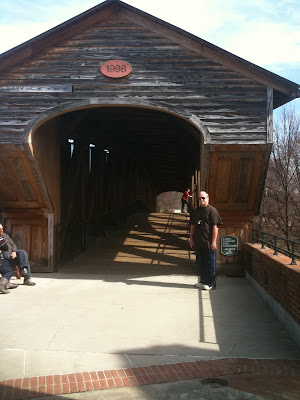In 1849 Forsyth County was established and Salem fathers didn't want Salem to be the county seat, so the church sold some property just north of Salem for the county courthouse to be built on. Thus Winston was "born." It wasn't until 1857 that residents were allowed to purchase their homes and Salem became an official municipality.
Salem merged with nearby Winston in 1913, becoming known as Winston-Salem. This was the only community to ever be officially designated as a hyphenated name for a Post Office by the US Postal Service.
One of the first architectural review districts in the country was formed in 1948 to save Salem from modern development and thus protect the historic remains of this amazing settlement of 1766. In 1950, Old Salem Inc. was created and has operated portions of this area as museums with period-dressed interpreters populating the area.
From the Visitor's Center you cross a modern main thoroughfare via this 1998 rustic-looking covered overpass.
Woodworking-John loves how things are constructed. I can imagine what would happen if you turned him loose in a lumber yard somewhere. I'm guessin' that would be heaven on earth for him!
The sides of the overpass are covered in heavy plexiglass. I'm sure it serves two purposes: blocking wind and snow, and preventing fools from throwing things off the bridge onto the road below.
One of the first areas you come to one block off of the main street is known as St. Philips Heritage Center. It includes the African Moravian Log Church, originally built in 1823,
the St. Philips African Moravian Church built in 1861 with an 1890 addition, a footpath that takes you to the Happy Hill Neighborhood overlook, and the African American and Strangers' Graveyard dating from 1775 to 1859. (Isn't that odd??)
The first house built in Salem was constructed in 1766 and has been reconstructed on site:
After the beams were put in place the openings were bricked in and then plastered over. I told John I could probably do that, but if someone wanted me to build a brick wall all by itself (with no beams), trust me, it would fall over in no time at all!!
Speaking of plastering:
I don't think it was all about decoration. I'm thinking this plastering was done to keep winter moisture from degrading the foundation, though they did plaster over only the rock on this foundation and left the brick exposed.
Apparently December and Christmas is the busiest season for Old Salem. I can imagine it is beautiful - especially with snow (which there has been next to none of this winter!) There weren't too many period-dressed folks about today.





No comments:
Post a Comment